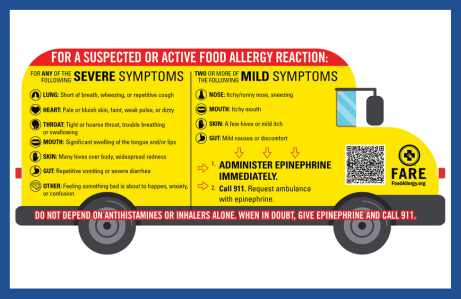Recognizing and Responding to a Reaction
Learning to recognize symptoms and how to react can help save the life of someone with food allergies.
Know how to react and respond to the life-threatening food allergy reaction, anaphylaxis
If two mild symptoms or just one severe symptom is being experienced, give epinephrine and call 911. Explore symptoms throughout the body and create a plan to react.
FOR ANY SEVERE SYMPTOMS
- ADMINISTER EPINEPHRINE IMMEDIATELY
- Call 911. Tell emergency dispatcher the person is having anaphylaxis and may need epinephrine when emergency responders arrive.
- Consider giving additional medications following epinephrine:
- Antihistamine
- Inhaler (bronchodilator) if wheezing
- Lay the person flat, raise legs and keep warm. If breathing is difficult or they are vomiting, let them sit up or lie on their side.
- If symptoms do not improve, or symptoms return, more doses of epinephrine can be given about 5 minutes or more after the last dose.
- Alert emergency contacts.
- Transport patient to ER, even if symptoms resolve. Patient should remain in ER for at least 4 hours because symptoms may return.
FOR MILD SYMPTOMS FROM MORE THAN ONE SYSTEM AREA, GIVE EPINEPHRINE AND CALL 911.
FOR MILD SYMPTOMS FROM A SINGLE SYSTEM AREA, FOLLOW THE DIRECTIONS BELOW:
- Antihistamines may be given, if ordered by a healthcare provider.
- Stay with the person; alert emergency contacts.
- Watch closely for changes. If symptoms worsen, give epinephrine and call 911.

Recognizing and Responding to a Reaction [School Bus Design]
This resource, available here in downloadable JPG format, has also been produced as a limited-run magnet.
This resource was supported by Cooperative Agreement Number 6 NU38PW000050-01-01, funded by the Centers for Disease Control and Prevention, in partnership with the American Academy of Pediatrics. Its contents are solely the responsibility of Food Allergy Research and Education and do not necessarily represent the official views of the American Academy of Pediatrics or the Centers for Disease Control and Prevention.


